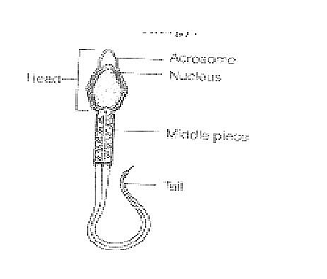The correct sequence of spermatogenetic stages leading to the formation of sperms in a mature human testis is
- spermatogonia $\to$ spermatocyte $\to$ spermatid $\to$ sperms
- spermatid $\to$ spermatocyte $\to$ spermatogonia $\to$ sperms
- spermatogonia $\to$ spermatid $\to$ spermatocyte $\to$ sperms
- spermatocyte $\to$ spermatogonia $\to$ spermatid $\to$ sperms
The Correct Option is A
Solution and Explanation
Top Questions on male reproductive system
- Which of the following converting a testis originates from peritoneum?
- MHT CET - 2025
- Biology
- male reproductive system
- Men produce sperms from which age onwards ?
- TS POLYCET - 2023
- Biology
- male reproductive system
- The testis are situated outside the abdominal cavity in scrotum as it helps to
- KCET - 2022
- Biology
- male reproductive system
- Which one of the labeled part utilisees fructose as a source of energy?

- JIPMER MBBS - 2019
- Biology
- male reproductive system
- The megasporangium proper of an angiosperm ovule is represented by
- MHT CET - 2017
- Biology
- male reproductive system
Questions Asked in NEET exam
A sphere of radius R is cut from a larger solid sphere of radius 2R as shown in the figure. The ratio of the moment of inertia of the smaller sphere to that of the rest part of the sphere about the Y-axis is :

- NEET (UG) - 2025
- Moment Of Inertia
- Two identical point masses P and Q, suspended from two separate massless springs of spring constants \(k_1\) and \(k_2\), respectively, oscillate vertically. If their maximum velocities are the same, the ratio of the amplitude of P to the amplitude of Q is :
- NEET (UG) - 2025
- Waves and Oscillations
- A microscope has an objective of focal length \(f_o = 2\) cm and an eyepiece of focal length \(f_e = 4\) cm. The tube length of the microscope is \(L = 40\) cm. If the distance of distinct vision of eye is \(D = 25\) cm, the magnification in the microscope is:
- NEET (UG) - 2025
- Optical Instruments
AB is a part of an electrical circuit (see figure). The potential difference \(V_A - V_B\), at the instant when current \(i = 2\) A and is increasing at a rate of 1 amp/second is:

- NEET (UG) - 2025
- Electromagnetic Induction and Inductance
- Twins are born to a family that lives next door to you. The twins are a boy and a girl. Which of the following must be true?
- NEET (UG) - 2025
- Genetics
Concepts Used:
Male Reproductive System
The male reproductive system contains the external genitals (the penis, testes and the scrotum) and internal parts, including the prostate gland, vas deferens, and urethra. A man's fertility and sexual traits depend on the normal functioning of the male reproductive system, as well as hormones released from the brain.
Read More: Human Reproductive System
Organs and functions:
The male reproductive system is responsible for reproduction. It is made of the following parts:
Penis — the organ used for urination and sexual intercourse. It has spongy tissue which can fill with blood to cause an erection. It contains the urethra, which carries both urine and semen.
Scrotum — this is a loose bag of skin that hangs outside the body, behind the penis. It holds the testes in place.
Testes (or testicles) — these are a pair of egg-shaped glands that sit in the scrotum, on the outside of the body. They produce sperm and testosterone, which is the male sex hormone.
Epididymis — this is a highly coiled tube that lies at the back of the testes. All sperm from the testes must pass through the epididymis, where they mature and start to ‘swim’.
Vas deferens — this is a thick-walled tube joined to the epididymis. It carries sperm from the epididymis up to the prostate gland and urethra.
Prostate gland — this is a walnut-sized gland that sits in the middle of the pelvis. The urethra runs through the middle of it. It produces the fluid secretions that support and nourish the sperm.
Urethra — this is a tube that extends from the bladder to the external opening at the end of the penis. The urethra carries both urine and sperm.
Seminal vesicles — these are 2 small glands above the prostate gland that make up much of the fluid in semen.